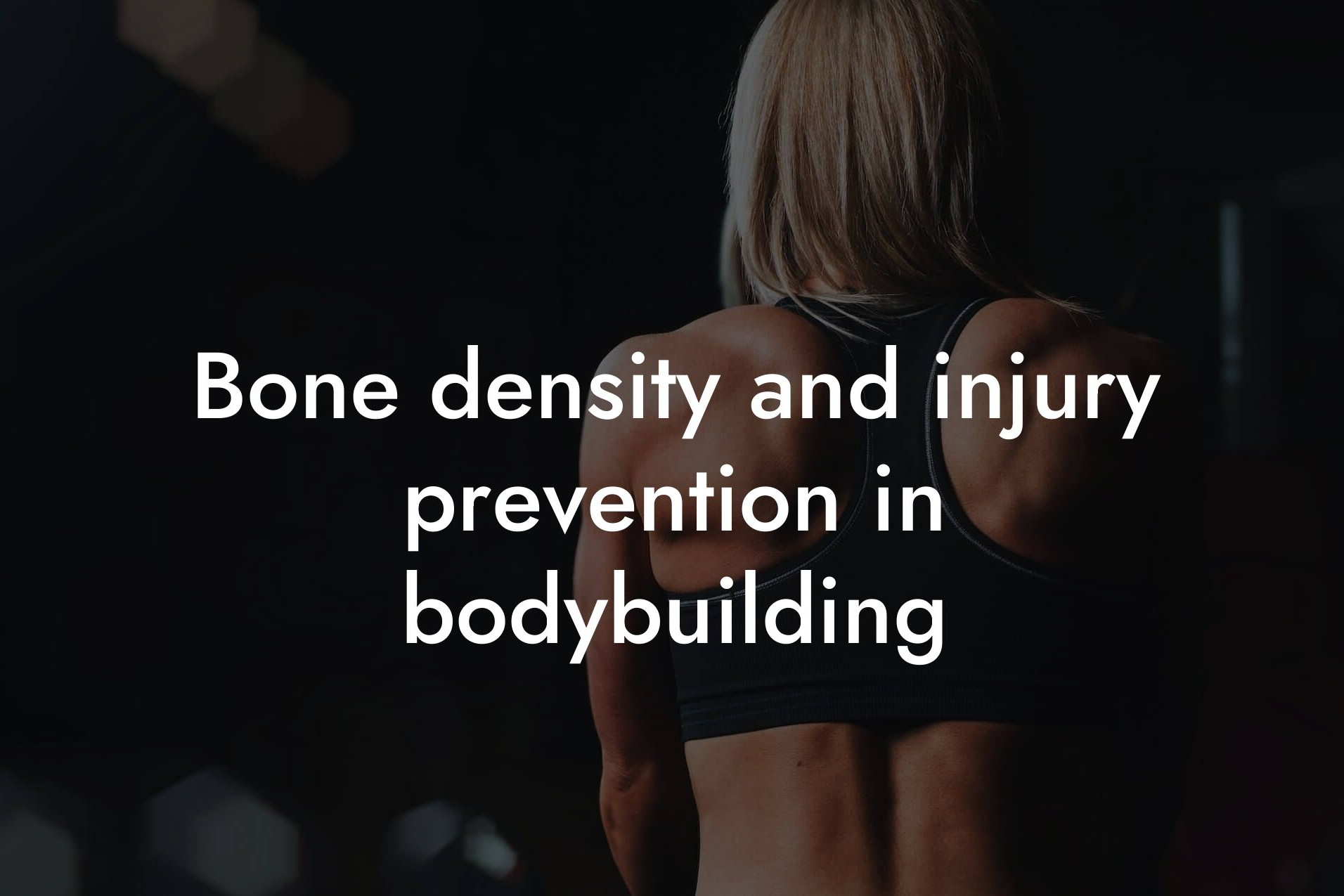As a high-earning professional, you understand the importance of presenting yourself in the best possible light. Your physical appearance can greatly impact your confidence, self-esteem, and even your business success. In the world of bodybuilding, muscle symmetry plays a crucial role in achieving a balanced and aesthetically pleasing physique. At Tano Performance Group, we believe that understanding the importance of muscle symmetry is essential for taking your body to the next level.
Table of Contents
What is Muscle Symmetry?
Muscle symmetry refers to the balance and proportion of muscle mass between the left and right sides of the body. It involves having equal or near-equal development of muscles on both sides, which is essential for achieving a balanced and harmonious physique. Muscle symmetry is not just about aesthetics; it's also crucial for optimal athletic performance, injury prevention, and overall health.
Why is Muscle Symmetry Important in Bodybuilding?
In bodybuilding, muscle symmetry is critical for achieving a well-balanced physique. A symmetrical body not only looks more pleasing to the eye, but it also indicates a high level of overall fitness and athleticism. When muscles are symmetrical, they work together more efficiently, allowing for better performance and reduced risk of injury. Additionally, muscle symmetry can boost confidence and self-esteem, which is essential for success in both personal and professional life.
The Consequences of Muscle Asymmetry
Muscle asymmetry can have serious consequences on athletic performance and overall health. When muscles are imbalanced, they can lead to poor posture, reduced range of motion, and increased risk of injury. Muscle asymmetry can also affect joint stability, leading to chronic pain and inflammation. Furthermore, muscle asymmetry can negatively impact self-esteem and confidence, making it more challenging to achieve success in personal and professional life.
Causes of Muscle Asymmetry
Muscle asymmetry can occur due to a variety of reasons, including:
- Genetic predisposition: Some individuals may be naturally more prone to muscle asymmetry due to genetic factors.
- Poor training habits: Focusing too much on one side of the body or neglecting certain muscle groups can lead to muscle asymmetry.
- Injury or trauma: Injuries or trauma to one side of the body can cause muscle imbalances and asymmetry.
- Poor posture: Chronic poor posture can lead to muscle imbalances and asymmetry.
How to Achieve Muscle Symmetry
Achieving muscle symmetry requires a combination of proper training, nutrition, and recovery. Here are some tips to help you achieve muscle symmetry:
- Train both sides of the body equally: Make sure to train both sides of the body with equal intensity and volume to avoid muscle imbalances.
- Focus on weak points: Identify your weak points and focus on training those areas to bring them up to par with the rest of your body.
- Incorporate unilateral exercises: Unilateral exercises, such as single-arm rows and single-leg squats, can help identify and address muscle imbalances.
- Stretch and foam roll regularly: Regular stretching and foam rolling can help improve flexibility and reduce muscle imbalances.
How DEXA Scans Can Help Achieve Muscle Symmetry
At Tano Performance Group, we use DEXA scans to provide a comprehensive body assessment, including muscle symmetry analysis. DEXA scans can help identify muscle imbalances and asymmetry, allowing you to target specific areas for improvement. By incorporating DEXA scans into your training program, you can:
- Identify muscle imbalances and asymmetry
- Track progress and make data-driven decisions
- Optimize your training program for maximum results
Muscle symmetry is a critical component of a well-balanced physique and overall fitness. By understanding the importance of muscle symmetry and taking steps to achieve it, you can improve your athletic performance, reduce the risk of injury, and boost your confidence and self-esteem. At Tano Performance Group, we are committed to helping high-earning professionals like you achieve their fitness goals through comprehensive body assessments and personalized training programs. Take the first step towards achieving muscle symmetry and unlocking your full potential.
Frequently Asked Questions
What is muscle symmetry and why is it important in bodybuilding?
Muscle symmetry refers to the balance and proportion of muscle mass on both sides of the body. It's essential in bodybuilding as it enhances overall physique, improves athletic performance, and reduces the risk of injuries. Symmetrical muscles also contribute to a more aesthetically pleasing appearance, which is a key goal for many bodybuilders.
How does muscle asymmetry affect athletic performance?
Muscle asymmetry can lead to uneven force production, altered movement patterns, and decreased power output. This can result in reduced athletic performance, increased fatigue, and a higher risk of injuries. In bodybuilding, muscle symmetry is crucial for optimal performance and achieving desired results.
What are the common causes of muscle asymmetry in bodybuilding?
Muscle asymmetry can be caused by various factors, including poor training techniques, inadequate recovery, and underlying muscle imbalances. Additionally, genetic factors, previous injuries, and poor posture can also contribute to muscle asymmetry.
How can I identify muscle asymmetry in my own body?
Self-assessment is key to identifying muscle asymmetry. Look for visible differences in muscle size, shape, and development between the left and right sides of your body. You can also perform exercises like single-arm rows, single-leg squats, or lateral raises to identify strength imbalances.
What are the consequences of ignoring muscle asymmetry in bodybuilding?
Ignoring muscle asymmetry can lead to chronic injuries, poor posture, and decreased athletic performance. It can also result in an uneven physique, which can be detrimental to bodybuilding goals. Furthermore, muscle asymmetry can lead to overcompensation patterns, causing additional strain on other muscle groups.
How can I correct muscle asymmetry in my training routine?
To correct muscle asymmetry, focus on exercises that target the weaker side of your body. Incorporate unilateral exercises, such as single-arm rows and single-leg squats, into your routine. Also, prioritize exercises that strengthen your core and improve overall muscle balance.
What role does proper warm-up and cool-down play in maintaining muscle symmetry?
Proper warm-up and cool-down routines are essential for maintaining muscle symmetry. A well-structured warm-up prepares the muscles for exercise, reducing the risk of injury and promoting balanced muscle activation. A thorough cool-down helps with recovery, reducing muscle soreness and promoting symmetrical muscle growth.
Can muscle asymmetry be caused by poor posture?
Yes, poor posture can contribute to muscle asymmetry. When you consistently adopt poor postural habits, certain muscle groups become overactive, while others become underactive, leading to muscle imbalances and asymmetry. Maintaining good posture is essential for promoting muscle symmetry.
How does muscle symmetry affect overall physique?
Muscle symmetry has a significant impact on overall physique. A symmetrical physique appears more aesthetically pleasing, with balanced muscle development and a more harmonious body shape. This is particularly important for bodybuilders, as a symmetrical physique is often a key goal.
Can muscle asymmetry be inherited?
Yes, muscle asymmetry can be inherited to some extent. Genetic factors can influence muscle development, leading to natural imbalances and asymmetries. However, this does not mean that muscle asymmetry cannot be corrected with proper training and exercise.
How long does it take to correct muscle asymmetry?
The time it takes to correct muscle asymmetry varies depending on the individual and the severity of the imbalance. With consistent and targeted training, you can start to see improvements in muscle symmetry within 6-12 weeks. However, it may take several months or even years to fully correct muscle asymmetry.
What is the role of stretching and foam rolling in maintaining muscle symmetry?
Stretching and foam rolling are essential for maintaining muscle symmetry. These techniques help to improve flexibility, reduce muscle tension, and promote balanced muscle growth. Regular stretching and foam rolling can also help to identify and address muscle imbalances.
How can I incorporate muscle symmetry into my daily routine?
Incorporate exercises that target muscle symmetry into your daily routine, such as single-arm rows, single-leg squats, and lateral raises. Also, prioritize proper posture, stretching, and foam rolling to promote balanced muscle growth and reduce muscle asymmetry.
What are the benefits of working with a personal trainer to correct muscle asymmetry?
Working with a personal trainer can be highly beneficial in correcting muscle asymmetry. A trainer can help identify muscle imbalances, develop a customized training program, and provide guidance on proper exercise technique and form.
How does muscle symmetry affect bone density?
Muscle symmetry has a significant impact on bone density. As muscle mass increases, bone density also increases, reducing the risk of osteoporosis and fractures. Symmetrical muscle development can also help to improve joint stability and reduce the risk of injuries.
Can muscle asymmetry be corrected with surgery?
In some cases, muscle asymmetry may require surgical correction, particularly if it's caused by a underlying medical condition or injury. However, surgery should be considered a last resort, and non-invasive methods such as exercise and physical therapy should be explored first.
How does muscle symmetry affect overall health and wellness?
Muscle symmetry has a significant impact on overall health and wellness. It can improve athletic performance, reduce the risk of injuries, and enhance overall physique. Additionally, muscle symmetry can also improve posture, reduce back pain, and promote better overall health.
What are the most common muscle groups affected by asymmetry?
The most common muscle groups affected by asymmetry are the shoulders, chest, back, and legs. These muscle groups are often prone to imbalances due to poor posture, inadequate training, and genetic factors.
How can I track my progress in correcting muscle asymmetry?
Track your progress by taking regular progress photos, measurements, and assessments of your strength and flexibility. Also, work with a personal trainer or coach to monitor your progress and make adjustments to your training program as needed.
What are the benefits of correcting muscle asymmetry for high-earning professionals?
Correcting muscle asymmetry can have numerous benefits for high-earning professionals, including improved athletic performance, enhanced physique, and reduced risk of injuries. Additionally, correcting muscle asymmetry can also improve overall health and wellness, leading to increased energy levels and productivity.
How can I maintain muscle symmetry over time?
Maintain muscle symmetry by continuing to prioritize exercises that target muscle balance, proper posture, and regular stretching and foam rolling. Also, make adjustments to your training program as needed to ensure continued progress and muscle symmetry.
Here are some related articles you might love...
- Bone density and injury prevention in bodybuilding
- Using DEXA scans to monitor progress in bodybuilding
- The role of body composition in bodybuilding success
- Nutrition strategies for muscle gain and fat loss in bodybuilding
- Recovery strategies for amateur bodybuilders
- Reducing body fat for competition in bodybuilding
- Strength training programs for amateur bodybuilders
- Off-season bulking and cutting cycles for bodybuilders
- How to optimize muscle growth with proper nutrition
Zak Faulkner
Zak Faulkner is a leading authority in the realm of physical health and body composition analysis, with over 15 years of experience helping professionals optimise their fitness and well-being. As one the experts behind Tano Performance Group, Zak has dedicated his career to providing in-depth, science-backed insights that empower clients to elevate their physical performance and overall health.
With extensive knowledge of DEXA technology, Zak specializes in delivering comprehensive body assessments that offer precise data on body fat, muscle mass, bone density, and overall physique. His expertise enables individuals to make informed decisions and achieve their fitness goals with accuracy and confidence. Zak’s approach is rooted in a deep understanding of human physiology, combined with a passion for helping clients unlock their full potential through personalised strategies.
Over the years, Zak has earned a reputation for his commitment to excellence, precision, and client-focused service. His guidance is trusted by top professionals who demand the best when it comes to their health. Whether advising on fitness programs, nutritional strategies, or long-term wellness plans, Zak Faulkner’s insights are a valuable resource for anyone serious about taking their health and fitness to the next level.
At Tano Performance Group, Zak continues to lead our Content Team revolutionising how professionals approach their physical health, offering unparalleled expertise that drives real results.




